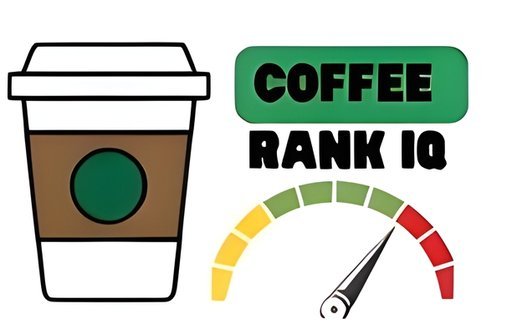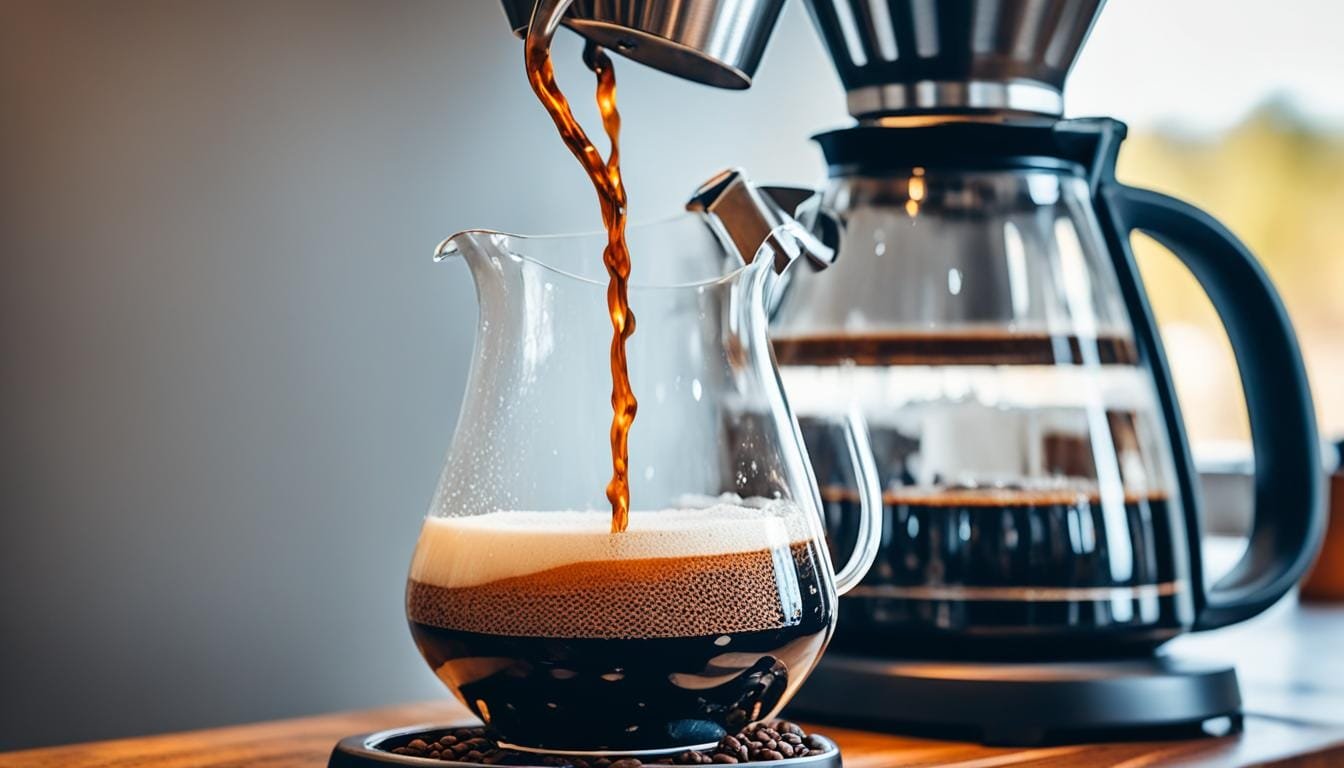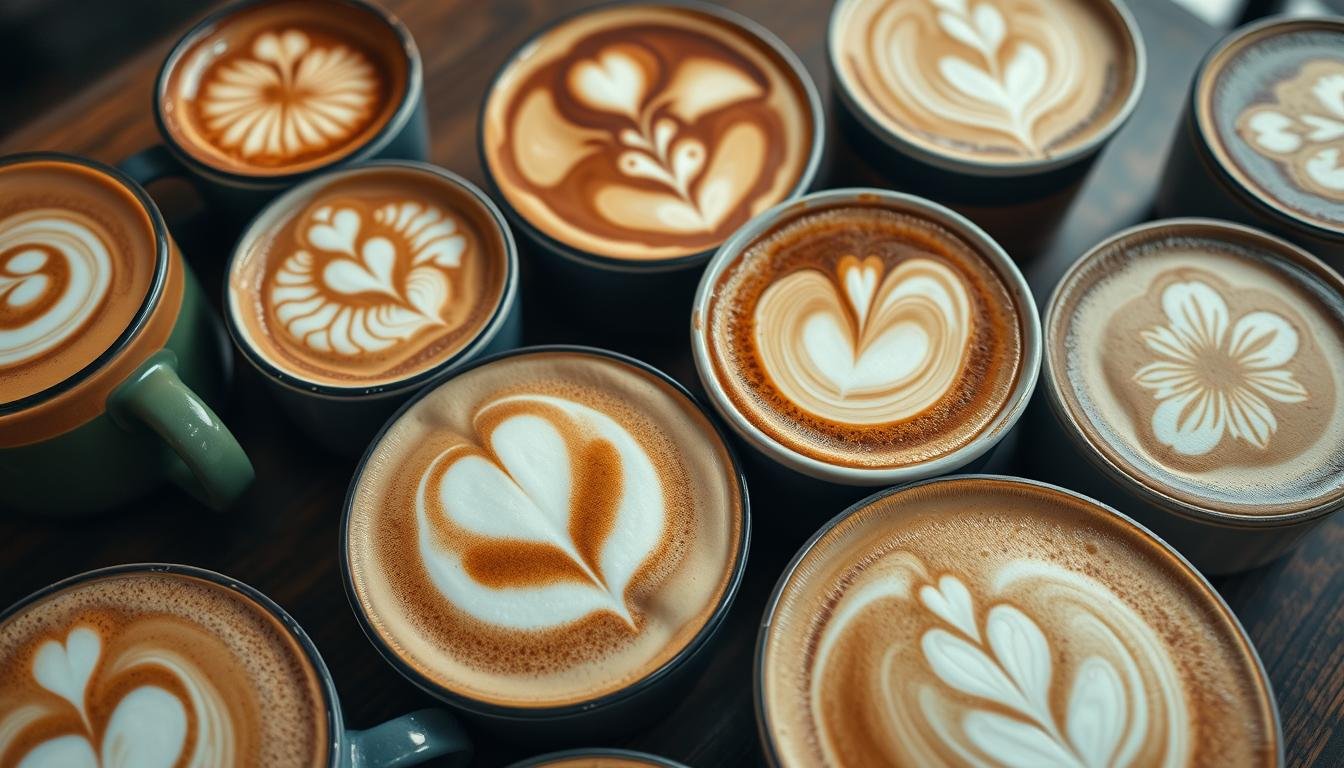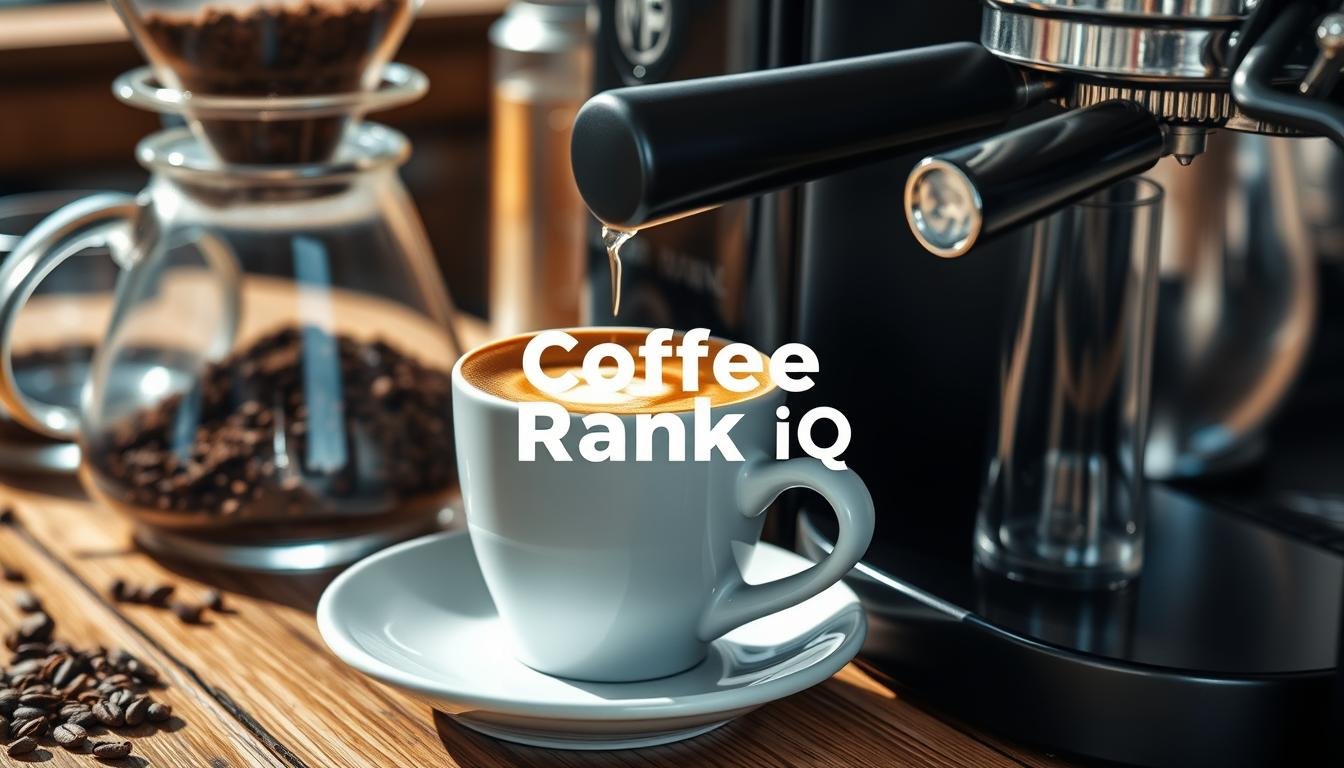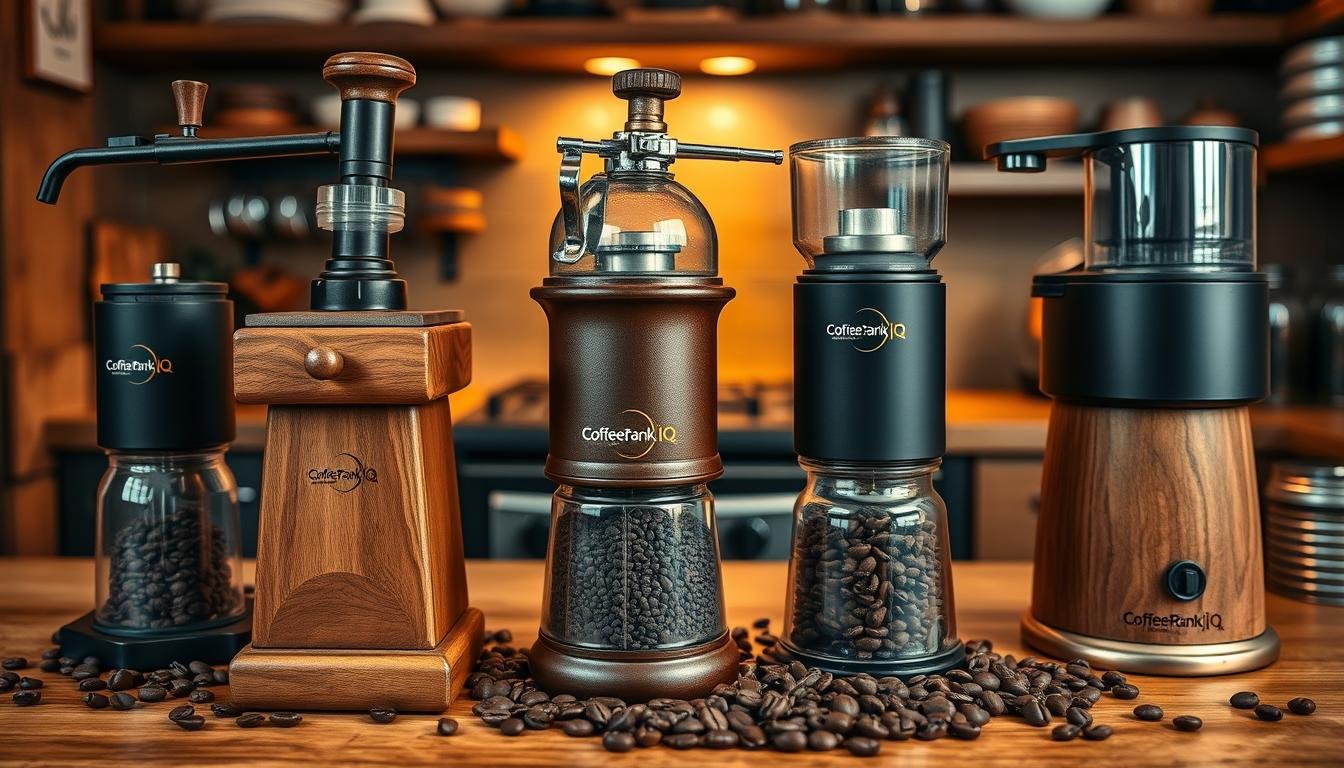Did you know that pour-over coffee makers are becoming increasingly popular in the coffee world? Manual brewers like the pour-over drippers have gained significant traction due to their ability to produce a clean and flavorful cup of coffee. If you’re new to pour-over brewing or simply want to up your coffee game, this beginner’s guide will take you through the basics of using a pour-over coffee maker and provide tips for a successful brewing experience.
Key Takeaways:
- Using a pour-over coffee maker allows for more control and precision in the brewing process.
- Investing in high-quality equipment, such as a pour-over dripper and grinder, is essential for consistent and delicious results.
- The grind size, coffee-to-water ratio, water temperature, and brewing technique all play crucial roles in achieving the desired flavor profile.
- Pour-over coffee offers advantages such as eco-friendliness, cost-effectiveness, and the ability to customize your brew.
- With practice and experimentation, you can master the art of pour-over brewing and enjoy a superior cup of coffee at home.
The Gear You Need
To make pour-over coffee, you will need a few essential tools and equipment. These include:
- Pour-Over Coffee Maker: Invest in a high-quality pour-over coffee maker like the Hario V60 or the Espro Bloom. These brewers are specifically designed to enhance the flavors and aromas of your coffee.
- Burr Grinder: A burr grinder ensures a consistent and uniform grind size, which is crucial for a balanced and flavorful pour-over brew.
- Slow-Pouring Kettle: A slow-pouring kettle with a gooseneck spout allows you to have precise control over the water flow, ensuring an even extraction and optimal flavor.
- Gram Scale: Accurately measuring your coffee and water is essential for achieving the perfect brew. A gram scale helps you maintain consistency and replicate your favorite recipes.
- Filters: Choose high-quality filters that fit your specific pour-over coffee maker. These help remove any unwanted particles and oils, resulting in a clean and delicious cup of coffee.
Having the right gear is crucial for a successful pour-over brewing experience. These tools will help you achieve consistent and high-quality brews, allowing you to savor the rich flavors and aromas of each cup.
The Grind Size and Consistency
The grind size and consistency of your coffee grounds play a crucial role in the flavor and overall quality of your pour-over brew. Achieving the right grind size is essential for optimal extraction and balanced flavors.
For pour-over coffee, a medium-coarse grind is generally recommended. This grind size allows for proper water flow, allowing the flavors to fully develop without over-extracting the coffee. A medium-coarse grind will result in a clean and vibrant cup of coffee.
To ensure consistency in your grind, it’s important to invest in a good quality burr grinder. Burr grinders provide a uniform grind size, which is essential for even extraction. Coffee Rank iQ recommends the Baratza Encore Burr Grinder, which offers a wide range of grind settings and consistent performance.
Remember, the grind size and consistency are key factors in achieving a delicious pour-over coffee. Take your time to find the right grind size for your taste preferences and experiment with different settings to perfect your brew.
“The grind size is crucial in pour-over brewing as it directly affects the flavor and extraction of the coffee. A consistent grind allows for even extraction and ensures that the flavors are properly balanced.”
| Grind Size | Method | Characteristics |
|---|---|---|
| Extra Coarse | Cold Brew | Very coarse, similar to breadcrumbs |
| Coarse | French Press | Gritty and chunky, like sea salt |
| Medium-Coarse | Pour-Over | Grains of sand with some small pebbles |
| Medium | Drip Coffee | Similar to granulated sugar |
| Medium-Fine | AeroPress | Slightly finer than table salt |
| Fine | Espresso | Fine powder, similar to powdered sugar |
The Ratio of Coffee to Water
The ratio of coffee to water is crucial in achieving the perfect pour-over brew. It determines the strength and flavor profile of your coffee, allowing you to customize your cup to your liking. The optimal brew ratio is approximately 1 gram of coffee for every 16.7 grams of water or 60 grams of coffee per liter of water. However, feel free to experiment with different ratios to find the balance that suits your taste buds.
Having the right coffee-to-water ratio ensures that your coffee is neither too weak nor too strong. It allows for proper extraction of the coffee grounds, resulting in a well-balanced and flavorful cup. By adjusting the ratio, you can tailor your brew to be more robust or milder, depending on your preference.
Remember, the ideal coffee-to-water ratio is just a starting point. Different coffee beans and personal preferences may require slight adjustments. It’s all about finding what works best for you and your palate.
“The ratio of coffee to water is the foundation of a great pour-over coffee. It’s like the recipe for the perfect cup. Once you find the right balance, you’ll be amazed at the depth of flavors you can achieve.”
– Coffee Rank iQ
To help you visualize the coffee-to-water ratio, refer to the table below:
| Coffee | Water |
|---|---|
| 15 grams | 250 grams |
| 20 grams | 333 grams |
| 30 grams | 500 grams |
| 40 grams | 667 grams |
| 60 grams | 1000 grams (1 liter) |
Remember, this is just a starting point and a general guideline. You can adjust the ratio based on your taste preferences and experiment with different combinations to discover your ideal brew.
The Water and Temperature
When it comes to making the perfect pour-over coffee, the quality of water used is just as important as selecting the right beans and grind size. The water you pour over your coffee grounds can significantly impact the overall flavor of your brew. To achieve a truly exceptional cup, consider the importance of water quality and brewing temperature.
Using filtered or high-quality water is recommended for pour-over coffee. This ensures that any impurities or off-flavors present in tap water don’t interfere with the delicate flavors of your coffee. Clean, pure water allows the natural characteristics of the beans to shine through, resulting in a more nuanced and enjoyable cup.
Beyond water quality, the brewing temperature is also crucial for a successful pour-over brew. The ideal range for water temperature is between 195°F and 205°F (90.5°C to 96°C). This range allows for optimal extraction, bringing out the desired flavors and aromas from the coffee beans.
Consistency is key when it comes to water temperature. Fluctuations in temperature can lead to inconsistent extraction and results. Investing in a gooseneck kettle with a built-in thermometer or temperature control feature can help you achieve and maintain the ideal brewing temperature throughout the brewing process.
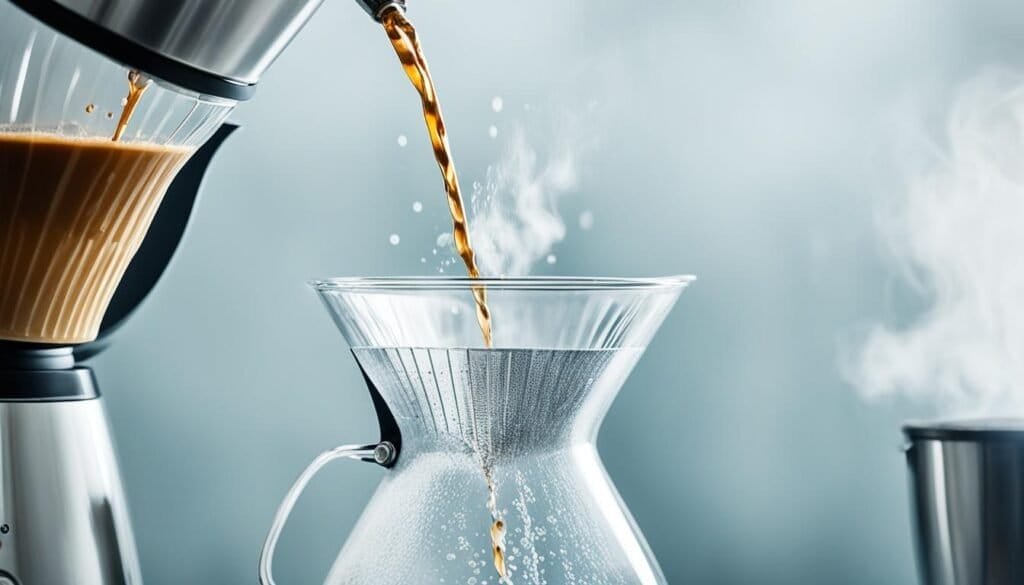
By prioritizing water quality and maintaining the ideal brewing temperature, you can elevate your pour-over coffee experience and unlock the full potential of your favorite beans. Remember, small details like these can make a big difference in the final taste of your cup.
The Brewing Technique
Mastering the brewing technique is essential for a great pour-over coffee. By following a step-by-step process and incorporating some tips, you can elevate your pour-over brewing skills and enjoy a delicious cup of coffee every time.
Step 1: Prepare the Equipment
Before you begin brewing, gather all your pour-over coffee equipment. This includes a pour-over coffee maker, a gooseneck kettle, a coffee grinder, a scale, and quality coffee filters.
Step 2: Wet the Filter
Place the coffee filter in the pour-over dripper, and then wet it with hot water. This removes any paper taste and preheats the brewer.
Step 3: Add Coffee Grounds
Measure the desired amount of coffee grounds according to your personal taste preferences. A general guideline is to use 1 to 2 tablespoons of coffee per 6 ounces of water. Place the coffee grounds in the wet filter.
Step 4: Bloom the Coffee
Blooming the coffee involves saturating the grounds with a small amount of hot water and allowing them to release carbon dioxide gas. This step enhances the flavor of your coffee. Start the bloom by pouring just enough water to cover the grounds. Let it sit for about 30 seconds before proceeding.
Step 5: Pour Slowly and Evenly
Now it’s time to pour the remaining hot water over the coffee grounds. Start at the center and pour in a slow, circular motion, making sure to evenly saturate all the grounds. Aim for a consistent pour rate to maintain control over the brewing process.
Step 6: Experiment and Refine
The beauty of pour-over brewing is the room for experimentation. Try adjusting different variables such as water temperature, grind size, and brewing time to achieve your desired flavor profile. Take notes and refine your technique along the way.
“The pour-over brewing technique requires practice and precision. It enables coffee enthusiasts to have complete control over the brewing process, resulting in a unique and flavorful cup of coffee.” – Coffee Rank iQ
By following these steps and practicing regularly, you’ll soon become proficient in the pour-over brewing technique. Remember to remain patient and enjoy the journey of discovering your perfect cup of pour-over coffee.
The Advantages of Pour-Over Coffee
Pour-over coffee offers several advantages compared to other brewing methods. One of the key benefits is the precise control it allows over the brewing process, resulting in a cleaner and more flavorful cup of coffee. With pour-over, you have the power to adjust variables such as water temperature, pour rate, and grind size, enabling you to customize your brew to perfection.
Unlike other brewing methods that rely on plastic pods or expensive machines, pour-over brewing is more eco-friendly and cost-effective. You don’t need to use single-use plastic pods, which helps reduce waste. Additionally, pour-over coffee makers are relatively affordable, making it a budget-friendly choice for coffee enthusiasts.
“Pour-over brewing allows you to extract the full potential of your coffee beans, showcasing their delicate flavors in every sip. It’s a method that encourages experimentation and exploration, as you can tweak various elements to achieve different taste profiles.”
– Coffee Rank iQ
Another advantage of using a pour-over coffee maker is the simplicity of the process. With just a few basic tools, such as a pour-over dripper, a gooseneck kettle, and a quality grinder, you can achieve exceptional results. Pour-over brewing is accessible to beginners and experts alike, providing a rewarding and satisfying coffee experience.
Pour-Over vs. Other Brewing Methods
Pour-over coffee differs from standard drip coffee, French press, and espresso in several ways.
Pour-over allows for more control over water temperature and flow rate, resulting in a more flavorful and less bitter cup of coffee. With the ability to adjust these variables, you can customize your brew to suit your taste preferences.
Compared to French press, pour-over coffee is cleaner and clearer. The paper filter used in pour-over brewing captures sediment and oils, resulting in a smoother and more refined cup of coffee. The absence of residue enhances the clarity of flavors and allows for a more nuanced coffee experience.
While pour-over coffee can be as strong as espresso, it does not require a special machine. You can achieve a robust and concentrated brew using a pour-over dripper and adjusting the coffee-to-water ratio. This flexibility allows you to explore different strength levels without the need for expensive equipment.
“Pour-over brewing unlocks the full potential of your coffee, showcasing its unique characteristics and flavors.” – Coffee Rank iQ
Differences between Pour-Over and Other Brewing Methods:
| Brewing Method | Water Control | Clarity and Cleanliness | Strength Flexibility |
|---|---|---|---|
| Pour-Over | High control over water temperature and flow rate | Cleaner and clearer cup of coffee | Flexible strength adjustment without special equipment |
| Drip Coffee | Less control over water temperature and flow rate | Potential for sediment and slightly heavier body | Standard strength based on machine settings |
| French Press | No control over water temperature and flow rate | Rich, full-bodied coffee with more sediment | Varies by steeping time, but limited adjustability |
| Espresso | Precise control over water temperature and flow rate | Intense and bold flavors with crema at the top | Requires specialized equipment for concentrated strength |
As seen in the table above, pour-over brewing offers a unique combination of control, clarity, and strength flexibility that sets it apart from other brewing methods.
<!–
Pour-Over vs. Other Brewing Methods
–>
Getting the Right Equipment
When it comes to brewing pour-over coffee, having the right equipment is essential. The right tools can make a significant difference in the taste and quality of your brew. Here are some essential pour-over coffee equipment that you should consider:
The Dripper: Hario V60
The Hario V60 is a popular choice among coffee enthusiasts for its excellent brew quality and versatility. Its unique cone shape and spiral ridges promote even extraction, resulting in a clean and flavorful cup of coffee. The V60 is available in various materials, including ceramic, glass, and plastic, allowing you to choose the one that suits your preferences.
The Gooseneck Kettle: Fellow Stagg EKG
A gooseneck kettle is crucial for controlling the pour speed and water flow during the brewing process. The Fellow Stagg EKG is highly recommended for its precise temperature control and ergonomic design. With its sleek and stylish appearance, it’s a statement piece for any coffee lover’s kitchen.
The Coffee Beans: Coffee Rank iQ’s Top Recommendations
Coffee Rank iQ is a trusted source that provides reviews and rankings of various coffee beans. Take the time to research and find beans that match your taste preferences. Some popular options include single-origin beans from Ethiopia, Colombia, and Costa Rica, known for their unique flavor profiles and complexity.
The Grinder: Baratza Encore
Investing in a quality burr grinder, such as the Baratza Encore, is crucial for achieving a consistent grind size. Consistency in grind size is vital for proper extraction and balanced flavors in your pour-over brew. The Baratza Encore offers a range of grind settings and ensures uniform particle size, giving you control over the extraction process.
The Filters: Hario V60 Paper Filters
Using high-quality filters is essential for a clean and sediment-free cup of coffee. The Hario V60 Paper Filters are designed specifically for the V60 dripper and feature a fine mesh that ensures optimal extraction while preventing grounds from entering your brew. They are available in different thicknesses to suit your brewing preference.
Remember, investing in high-quality and precise pour-over coffee equipment will set you up for brewing success. Take the time to explore different options and find the gear that suits your preferences and brewing style.
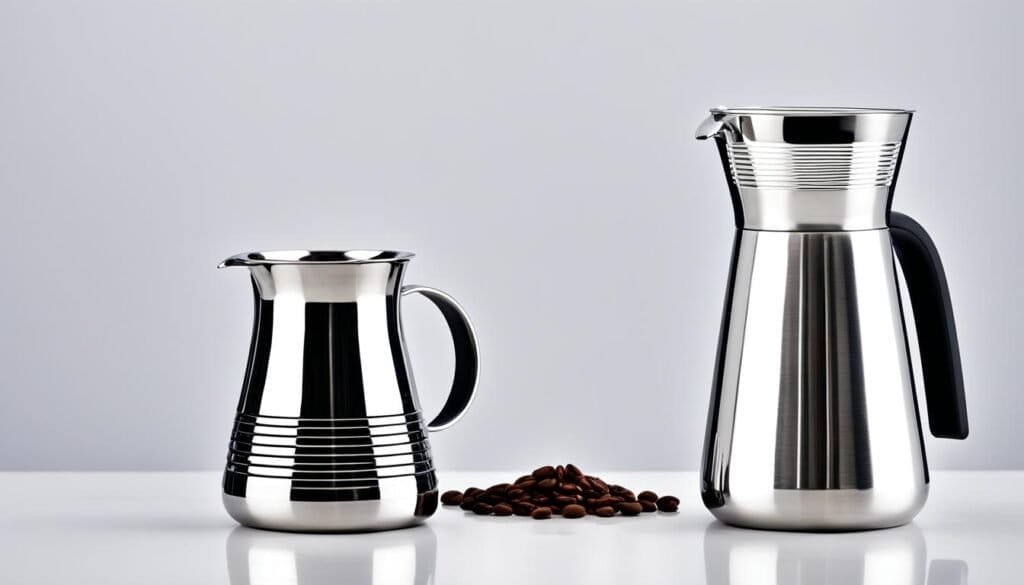
Step-by-Step Guide to Making Pour-Over Coffee at Home
Making pour-over coffee at home is an enriching and rewarding experience that allows you to fully immerse yourself in the art of artisanal brewing. By following this step-by-step pour-over coffee guide, you’ll be able to enjoy a flavorful and aromatic cup of coffee in the comfort of your own home.
Before we begin, make sure you have the necessary equipment:
- A pour-over coffee maker (such as a Hario V60 or an Espro Bloom)
- A burr grinder
- A slow-pouring kettle
- A gram scale
- Filters
Now, let’s dive into the process:
- Select and grind your coffee beans: Start by choosing high-quality coffee beans that suit your flavor preferences. Use a burr grinder to grind the beans to a medium-coarse consistency. This grind size is ideal for pour-over brewing and ensures optimal extraction.
- Prepare the equipment and filter: Set up your pour-over coffee maker on a stable surface. Place a filter in the dripper and rinse it with hot water to remove any paper residues. This step also preheats the brewing vessel and removes any potential paper flavor.
- Measure the appropriate amount of coffee and water: Use a gram scale to measure the desired amount of coffee according to your preferred coffee-to-water ratio. A general guideline is to use 1 gram of coffee for every 16.7 grams of water. You can adjust the ratio to achieve your desired strength and flavor.
- Follow the recommended brewing technique:) over the coffee grounds and allowing them to bloom for around 30 seconds. This process releases trapped gases and enhances flavor extraction. Then, slowly and steadily pour the remaining hot water in a circular motion over the grounds. Aim for an even saturation and maintain a consistent flow rate. Allow the coffee to drip into the brewing vessel in a controlled manner.
Pro tip: Experiment with different pouring techniques, such as the “pulse pour” or the “continuous pour,” to achieve different flavor profiles in your cup of pour-over coffee. Each brewing technique can enhance or highlight certain characteristics of the coffee.
6. Be patient and pay attention to detail: Pour-over brewing requires precision and attentiveness. Maintain a steady and controlled pouring speed, ensuring that the water doesn’t flow too quickly or too slowly. Monitor the extraction time and adjust your technique if necessary.
7. Once the brewing is complete, remove the dripper and discard the used filter. You can now enjoy your freshly brewed pour-over coffee. Pour it into your favorite mug, savor the aroma, and indulge in the rich flavors of your own handcrafted creation.
By following this step-by-step pour-over coffee guide, you’ll be able to consistently brew a delicious cup of pour-over coffee that rivals the offerings of your favorite coffee shop. With practice, you’ll develop your own unique brewing style and be able to experiment with different coffee beans and flavor profiles. So don’t hesitate—grab your pour-over coffee maker and start your journey to coffee perfection today!
Conclusion
Pour-over coffee brewing is a rewarding and enjoyable method for brewing coffee. It allows you to have complete control over the brewing process, ensuring that each cup is tailored to your preferences. By following the steps and tips outlined in this guide, you can master the art of pour-over coffee and elevate your home brewing experience.
Through the use of high-quality equipment and precise brewing techniques, pour-over coffee enables you to unlock the full potential of your coffee beans. The combination of the right grind size, water-to-coffee ratio, and water temperature results in a rich and flavorful cup of coffee that is free from bitterness and sediment.
As you embark on your pour-over journey, remember to be patient and experiment with different variables. The beauty of pour-over brewing is that you can adjust each element to suit your taste. Whether you prefer a bold and strong cup or a delicate and nuanced brew, pour-over coffee can deliver it all.
In summary, pour-over coffee brewing offers a level of artistry and craft that is unparalleled in other brewing methods. When done right, it produces a cup of coffee that is pure, flavorful, and satisfying. So grab your favorite pour-over coffee maker, gather your equipment, and start brewing your way to a truly exceptional coffee experience.
FAQ
What equipment do I need to make pour-over coffee?
To make pour-over coffee, you will need a pour-over coffee maker, a burr grinder, a slow-pouring kettle, a gram scale, and filters.
What grind size should I use for pour-over coffee?
A medium-coarse grind is recommended for pour-over coffee to allow for proper extraction and balanced flavors.
What is the ratio of coffee to water for pour-over coffee?
The standard ratio is approximately 1 gram of coffee for every 16.7 grams of water or 60 grams of coffee per liter of water. However, you can adjust this ratio to your liking.
What type of water should I use for pour-over coffee?
It is recommended to use filtered or high-quality water to enhance the taste of your brew.
What is the ideal brewing temperature for pour-over coffee?
The ideal brewing temperature ranges from 195°F to 205°F (90.5°C to 96°C).
What is the brewing technique for pour-over coffee?
Start by wetting the filter, adding coffee grounds, and blooming the coffee. Then, pour the water slowly and evenly over the grounds, allowing for proper extraction.
What are the advantages of using a pour-over coffee maker?
Pour-over coffee offers precise control over the brewing process, resulting in a cleaner and more flavorful cup. It is also a more eco-friendly and cost-effective choice compared to plastic pods and expensive machines.
How does pour-over coffee differ from other brewing methods?
Pour-over coffee allows for more control over water temperature and flow rate, resulting in a more flavorful and less bitter cup. It is cleaner and clearer compared to French press and offers more flexibility in adjusting strength compared to espresso.
What equipment do I need for pour-over coffee brewing?
You will need a dripper, gooseneck kettle, coffee beans, grinder, and filters.
How do I make pour-over coffee at home?
Start by selecting and grinding your coffee beans, then prepare the equipment and filter. Measure the appropriate amount of coffee and water, and follow the recommended brewing technique.
What is the conclusion of this beginner’s guide to pour-over coffee?
Pour-over coffee brewing is a rewarding and enjoyable method that offers control and precision. By following the steps and tips outlined in this guide, you can elevate your home coffee brewing experience and enjoy the rich flavors of pour-over coffee.
